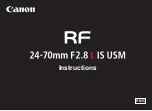
ENG-1
❸
CT1-8615-000
❶
❷
❸
Wide end
Telephoto end
Zoom ring
ENG
EF-M LENS Instructions
EF-M18-150mm f/3.5-6.3 IS STM
①
②
③
④
⑤
⑥
⑦
⑧
Nomenclature
①
Focusing ring
②
Hood mount
③
Filter mounting thread
④
Lens mount index
⑤
Contacts
⑥
Zoom position index
⑦
Zoom ring
⑧
Focal length indicator
Thank you for purchasing a Canon product.
The Canon EF-M18-150mm f/3.5-6.3 IS STM is a high-
magnification zoom lens for use on Canon EOS M Series
cameras.
• "IS" stands for Image Stabilizer.
• "STM" stands for stepping motor.
Camera Firmware
Please use the latest version of firmware with the camera in
use. For details on whether the firmware is the latest version or
not, and for details on updating the firmware, please check the
Canon website.
Conventions used in this instruction
Warning to prevent lens or camera malfunction or damage.
Supplementary notes on using the lens and taking pictures.
Safety Precautions
Precautions to ensure that the camera is used safely. Read
these precautions thoroughly. Make sure all details are
observed in order to prevent risks and injury to the user and
other people.
Warning
Details pertaining to risks that may result in death
or serious injury.
•
Do not look at the sun or a bright light source through the
lens.
Doing so could result in vision loss or blindness.
• Whether it is attached to the camera or not, do not leave
the lens under the sun without the lens cap attached.
This
is to prevent the lens from concentrating the sun’s rays, which
could cause a fire.
Caution
Details pertaining to risks that may result in injury.
• Do not leave the camera in locations subject to high or
low temperatures.
This may result in the camera becoming
excessively hot or cold, which may cause burns or other
injuries when touched.
Caution
Details pertaining to risks that may result in damage to
property.
• Do not leave the lens in excessive heat such as in a car
in direct sunlight. High temperatures can cause the lens to
malfunction.
General Precautions
Handling Precautions
• If the lens is taken from a cold environment into a warm one,
condensation may develop on the lens surface and internal
parts. To prevent condensation in this case, first put the lens
into an airtight plastic bag before taking it from a cold to warm
environment. Then take out the lens after it has warmed
gradually. Do the same when taking the lens from a warm
environment into a cold one.
• Please also read any lens related handling precautions listed
in your camera’s instruction manual.
This device complies with Part 15 of the FCC Rules. Operation is
subject to the following two conditions: (1) This device may not cause
harmful interference, and (2) this device must accept any interference
received, including interference that may cause undesired operation.
Do not make any changes or modifications to the equipment unless
otherwise specified in the instructions. If such changes or modifications
should be made, you could be required to stop operation of the
equipment.
This equipment has been tested and found to comply with the limits for
a class B digital device, pursuant to part 15 of the FCC Rules. These
limits are designed to provide reasonable protection against harmful
interference in a residential installation. This equipment generates, uses
and can radiate radio frequency energy and, if not installed and used
in accordance with the instructions, may cause harmful interference to
radio communications.
However, there is no guarantee that interference will not occur in a
particular installation. If this equipment does cause harmful interference
to radio or television reception, which can be determined by turning
the equipment off and on, the user is encouraged to try to correct the
interference by one or more of the following measures:
• Reorient or relocate the receiving antenna.
• Increase the separation between the equipment and receiver.
• Connect the equipment into an outlet on a circuit different from
that to which the receiver is connected.
• Consult the dealer or an experienced radio/TV technician for
help.
CAN ICES-3 (B) / NMB-3 (B)
1. Mounting and Detaching the Lens
See your camera’s instructions for details on mounting and
detaching the lens.
•
After detaching the lens, place the lens with the rear end
up to prevent the lens surface and contacts from getting
scratched. (fig.
❶
)
•
Contacts that are scratched, soiled, or have fingerprints on
them may result in faulty connections or corrosion, which
may lead to malfunctions. If the contacts get soiled, clean
them with a soft cloth.
•
Attach the lens cap and dust cap when disconnecting the
lens. When attaching the dust cap, align the lens mount
index with the
k
index of the dust cap and rotate in a
clockwise direction as shown in the illustration. (fig.
❷
)
Follow the reverse procedure to detach it.
2. Zooming
Turn the lens’ zoom ring to adjust the size of the photo field or
subject. (fig.
❸
)
• For wide shots, turn the zoom ring toward the wide end.
• For close-ups, turn the zoom ring toward the telephoto end.
•
Be sure to finish zooming before focusing. Zooming after
focusing can affect the focus.
•
Blurring may temporarily occur if the zoom ring is quickly
rotated.
•
Zooming during still image exposure will result in delayed
focus. This causes any streaks of light that are captured
during exposure to be blurred.




